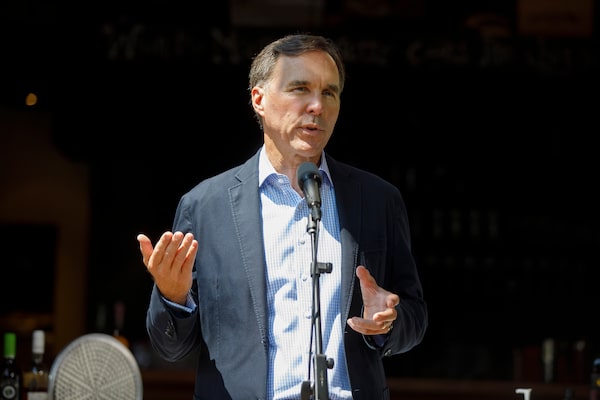
Canada's Minister of Finance Bill Morneau speaks to media during a press conference in Toronto, July 17, 2020.Cole Burston/The Canadian Press
The federal government announced major changes to the Canada Emergency Wage Subsidy Friday, making the benefit available to more businesses while also laying out a plan to gradually wind down the program by December.
Finance Minister Bill Morneau made the announcement at an Italian restaurant in Toronto.
The changes respond to the main complaint from business owners about the original program: It was only open to firms that could demonstrate at least a 30-per-cent revenue decline. The new rules are retroactive to July 5, but require parliamentary approval.
The revised program adjusts the size of the federal benefit based on the degree of revenue decline. It includes a new top-up to the subsidy, which is also proportional, for the hardest-hit businesses that are experiencing a revenue drop of more than 50 per cent. The program also gives employers options for measuring their revenue decline.
Mr. Morneau told reporters the revised program is aimed at helping businesses hire employees as the economy begins to recover.
“We know that the requirement that businesses have a 30-per-cent reduction in revenue is not helpful in that regard. So what we’re saying is that businesses will get the wage subsidy if they’ve had any reduction in revenue. So, it’s going to go all the way down to businesses who even have a small amount of revenue reduction. They’ll get the subsidy as well, and it will be in proportion to the amount of their revenue reduction,” he said.
The size of benefits will also decline gradually over time until December.
Mr. Morneau said draft legislation to implement the changes was sent to opposition parties Friday. The House of Commons is scheduled to sit for one day on Wednesday, meaning the bill could be passed if the opposition parties agree.
Canadian Federation of Independent Business President Dan Kelly said the main changes are positive and give business owners some certainty over the coming months. But he also said the new rules are confusing and some employers may be surprised by how sharply the size of the benefit is scheduled to decline.
“It’s a pretty aggressive phase-out of the subsidy,” he said.
Conservative finance critic Pierre Poilievre expressed a similar view.
“We’ve long called for the government to remove the penalties for companies that recuperate their pre-COVID revenues, so we’re happy that the government is trying to address that,” he said. “However, they’ve created a cobweb of complexity that will trap many businesses. The formula for determining how much businesses get is extremely complicated and will require an army of accountants to untangle.”
NDP Finance critic Peter Julian said the new rules are “definitely an improvement” and in line with what businesses and the NDP have long called for.
The federal government signaled in its fiscal snapshot that a revised wage subsidy program would be a key part of its approach this fall to support the re-opening of workplaces.
In the initial stages of the COVID-19 crisis, there was strong debate in policy circles over whether it was better to provide income support directly to individuals or funnel it through employers as a way of keeping workers on company payrolls.
The government initially announced a 10-per-cent wage subsidy on March 18.
The next week, the Liberals opted to focus on individuals and announced the Canada Emergency Response Benefit (CERB), a taxable $2,000 monthly payment for people who had lost nearly all of their income due to COVID-19.
Prime Minister Justin Trudeau later announced a new wage subsidy that would cover up to 75 per cent of an employee’s wages to a maximum of $847 a week.
In early April, the government expected the CERB would cost $24-billion and the wage subsidy would cost $71-billion. But the CERB received far more take-up than the wage subsidy.
As of this week, the federal government has paid out $20.4-billion through the wage subsidy and $59.4-billion through the CERB.
The fiscal snapshot revealed the government expects the CERB will cost $80.5-billion and the wage subsidy $82.3-billion, which suggests a much stronger take-up for the wage subsidy later this year.
The government revised its wage subsidy cost estimate Friday to $83.6-billion. Mr. Morneau said no decision has been made on the future of the CERB.
TD Senior Economist Brian DePratto said in a note that the revised rules should boost employment and respond to concerns expressed by industry groups.
“Some sectors may take longer to recover, but this extension should help change the hiring calculus for many firms,” he said.
Benjamin Bergen, executive director of the Council of Canadian Innovators, said in a statement that the extension is welcome, but employers should be able to use other measures of activity, such as subscription revenue or billable hours, to qualify for the subsidy.
Know what is happening in the halls of power with the day’s top political headlines and commentary as selected by Globe editors (subscribers only). Sign up today.
 Bill Curry
Bill Curry